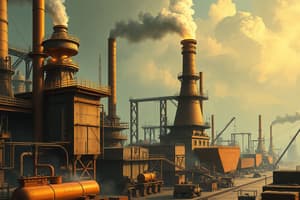Podcast
Questions and Answers
What was one major effect of the Bessemer steel process during the Second Industrial Revolution?
What was one major effect of the Bessemer steel process during the Second Industrial Revolution?
- It increased the use of coal in manufacturing.
- It eliminated the need for skilled laborers.
- It led to the creation of the automobile industry.
- It reduced the cost of steel production. (correct)
How did scientific management impact laborers during the Second Industrial Revolution?
How did scientific management impact laborers during the Second Industrial Revolution?
- It made them more efficient and productive. (correct)
- It improved their working conditions.
- It allowed for more leisure time.
- It increased their wage levels.
What was the primary aim of corporations during the Second Industrial Revolution?
What was the primary aim of corporations during the Second Industrial Revolution?
- To create monopolies and eliminate competition. (correct)
- To provide fair wages to all workers.
- To support government regulations.
- To diversify their industrial processes.
Which method was used to achieve vertical integration?
Which method was used to achieve vertical integration?
What was one of the attempts made to regulate anti-competitive practices during this era?
What was one of the attempts made to regulate anti-competitive practices during this era?
Flashcards are hidden until you start studying
Study Notes
The Second Industrial Revolution
- Profoundly transformed industry in the United States during the late 19th century.
- Bessemer steel process revolutionized steel production, making it cheaper and more efficient, which mechanized manufacturing significantly.
Scientific Management
- Aimed to enhance efficiency and productivity among laborers.
- Increased output came at the cost of worker dehumanization and diminished job satisfaction.
Business Organization Evolution
- Corporations aimed to outsmart competition in the free market.
- Strategies included forming pools and achieving monopolies as the ultimate goal.
Monopolistic Practices
- Horizontal integration: control over a market for a specific good through mergers or acquisitions with competitors.
- Vertical integration: controlling the entire production process from raw materials to final product distribution.
Government Regulation
- Little regulatory oversight was in place to curb anti-competitive practices during this period.
- The Sherman Antitrust Act was an early attempt to restrict monopolies and promote competition, though enforcement was limited.
Studying That Suits You
Use AI to generate personalized quizzes and flashcards to suit your learning preferences.




